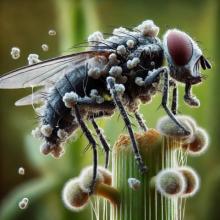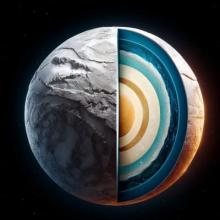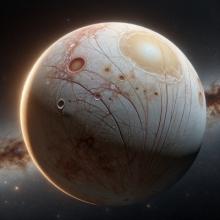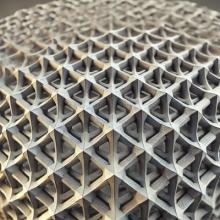Scientists have recently made a significant discovery in the field of quantum physics, focusing on a material called FeSn, which has a unique structure known as a kagome lattice. This lattice resembles a traditional Japanese basket-weaving pattern and is known for its intriguing electronic properties. This discovery may have promising implications for research in quantum computing.
Science

Recent studies have revealed that Ceres, the largest object in the asteroid belt, is more than a rocky celestial body; it’s actually a frozen ice world. Scientists analyzing data from NASA’s Dawn spacecraft discovered that Ceres contains a significant amount of water ice beneath its crust, particularly at mid-to-high latitudes. This has led to the conclusion that Ceres could hold vast ice deposits, potentially mixed with salts and clays.

The Fungus That Turns Healthy Flies into Zombie Flies
In the world of insects, a terrifying phenomenon is caused by a type of fungus that takes control of flies and turns them into "zombies." This fungus, from the Entomophthora genus, infects the flies, manipulating their behavior before eventually killing them. The way this fungus works is both fascinating and gruesome, showcasing the strange power of nature. Scientists have been studying this fungus, analyzing its DNA, which is much larger than most other fungi.

Scratching is a common behavior in cats that can lead to significant issues when it targets furniture or other household items. A recent study published in Frontiers in Veterinary Science delves into controlling cat scratching, offering insights into why cats scratch and how to manage this behavior effectively.

Introduction
Melanoma, a severe form of skin cancer, has been notoriously challenging to treat. A recent breakthrough in melanoma treatment, published in Nature Nanotechnology, explores the potential of using tyrosine, an amino acid, to target melanoma cells effectively. This innovative approach combines nutrient delivery with advanced therapeutic techniques to inhibit tumor growth and enhance treatment efficacy.

Gene Therapy Restores Hearing in Recent Trial
Gene therapy is showing promise in restoring hearing for children born deaf due to genetic conditions. Recent research published in Nature Medicine reports on a trial involving five children with autosomal recessive deafness 9 (DFNB9). This condition is caused by mutations in the OTOF gene, which leads to a lack of the protein necessary for hearing.

Exploring the Hidden Oceans: Dwarf Planets Beyond Pluto and the Quest for Life
Far beyond the familiar planets of our solar system lies a mysterious realm of dwarf planets, like Pluto and its distant cousins. These celestial bodies, residing in the cold, dark expanse of space, might hold the key to one of humanity's greatest questions: Are we alone in the universe? Scientists believe that there may be liquid oceans in dwarf planets beneath their icy surfaces, potentially creating habitats where unknown life could exist.
The Mystery Beneath the Ice

The cosmos has always been a source of mystery and fascination, prompting scientists to delve into its depths to uncover the secrets of our existence. One of the most groundbreaking ideas in recent times comes from a paper by John Ellis et al., titled "Do we owe our existence to gravitational waves?" This article aims to summarize the essence of their research, shedding light on the pivotal role that gravitational waves may play in the very fabric of our being and the universe at large.
Introduction to Gravitational Waves

The quest to uncover extraterrestrial life takes a fascinating turn with a groundbreaking study by the University of Washington in Seattle and the Freie Universität Berlin. This research highlights the intriguing potential of ice grains in space ejected from celestial bodies like Europa and Enceladus to carry signs of life. As NASA gears up for an ambitious mission to Europa, this study sheds light on the cosmic breadcrumbs that may lead us to discover life beyond Earth.

INRS Professor Fabio Boschini is at the forefront of quantum materials research, advancing the field of ultrafast science, particularly through his work with time- and angle-resolved photoemission spectroscopy (TR-ARPES). Boschini, who holds a faculty position at Quebec’s Institut National de la Recherche Scientifique (INRS), focuses on leveraging high-intensity, long-wavelength light excitations to explore and influence novel quantum phases of matter that have no equilibrium counterparts. His research aims to access and manipulate the dynamic properties of complex systems, offering new insights into the behavior of quantum materials under non-standard conditions.
Copyright 2024-2025 Edwin M. Basye. All rights reserved.

